
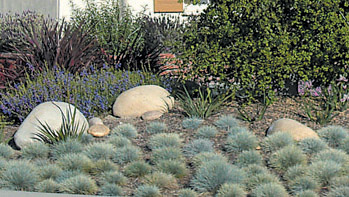
Contributor
- Topics: Archive
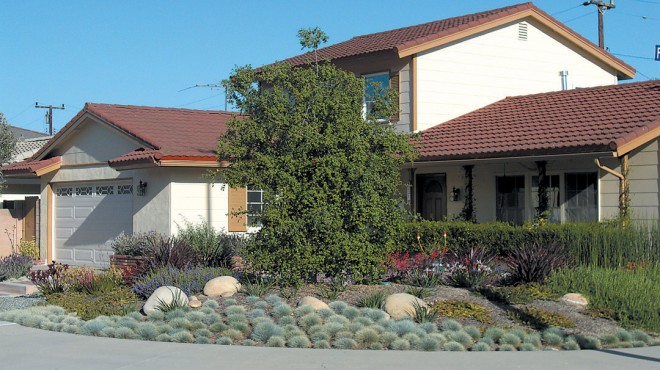
Walking briskly, I entered our library in Huntington Beach, hoping that the free presentation on “California-Friendly Gardening for the Water-Wise Gardener” had not commenced. Landscape architect Guy Stivers began his talk just as I sat down. He expounded, in a learned yet accessible way, on responsible water management coupled with organic landscaping. Guy described plants that particularly suited Southern California—tough, adaptable, drought-resistant plants that were colorful most of the year. Illustrating his presentation was a myriad of photographs that actually stunned me with their beauty—such lovely hues, interesting textures, and striking shapes. Afterwards, I approached Guy, who was surrounded by enthusiasts, to ask for his business card. He also provided me with a copy of the MWD presentation (Metropolitan Water District of Southern California). I went home immediately to share the epiphany with Amanda, my life partner. That day in 2008, our transformation from unschooled consumers to involved citizens—via gardening—began in earnest.
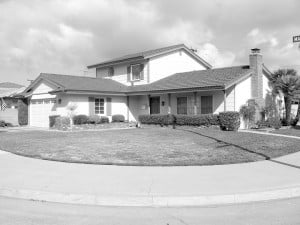
We had purchased a home built in 1963, when the norm was smaller houses and larger yards in Huntington Beach. It was a fairly spacious corner property, which sported The Lawn in front and a few foundation shrubs. Over the decades, it became dominated by crabgrass. At first, Amanda and I remained stuck in lawn mode, daring only to consider replacing the entire area with a new, water-friendly type of grass. But we realized that this was an inadequate solution for on-going issues of water scarcity and drought—problems that felt increasingly urgent to us. How would California be able to provide sufficient safe water in the future for people, businesses, and vital industries such as agriculture? Turning from the macro to the micro, did we have to content ourselves with cacti and colored gravel to help save the planet?
When Guy first visited, we opened the door to observe him intently viewing the front yard; he was immediately struck by how exposed the house was to the busy street. This first meeting with Guy was inspirational as we discussed multiple options that would translate, approximately one year later, into our beloved garden. Guy’s credentials are impressive: a landscape architect and arborist involved in environmental planning and urban forestry, he offers his expertise voluntarily to Bolsa Chica Wetlands and Shipley Nature Center, where he is in charge of long-term projects. Guy was the master architect on the Sun Valley, California renovation that transformed a neighborhood into a water-wise and solar-lit community.
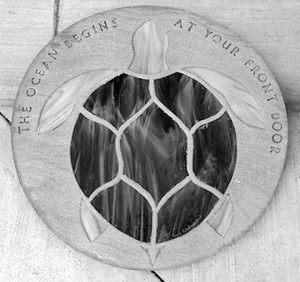
Guy soon created a design for our front and back yards, and we hired a contractor. The ensuing months were filled with a combination of anticipation, frustration, and joy—sometimes all in the same day. We both work fulltime. After the work-day was over, our avocation became the creation of our garden and the study of horticulture.
Guy educated us about water conservation and efficiency, which we wanted to address as thoroughly as possible within the confines of our landscape. Water conservation measures are often short-term; water efficiency is intended to create permanent methods to simultaneously reduce consumption and save money. The less you use, the less water is pumped, treated, stored, and distributed—and that helps everyone.
Another concern is that of run-off, especially exacerbated when it rains heavily. According to SurfRider Foundation, gardeners greatly affect the ocean in two ways. First, we influence the amount of water running off a landscape, since thirty to eighty percent of a homesite can comprise impermeable surfaces. Second, we influence the quality of water coming from our properties; such runoff can contain fertilizers, pesticides, oils, cleaning solutions, and organic debris.

Keeping Water Onsite
First, the underlying structure of the garden was installed to capture water and distribute it within the site. Water capture is accomplished through the use of three sixty-gallon CUDO Cubes. Manufactured in Southern California of one hundred percent recycled polypropylene plastic perforated with holes, these two-foot square cubes are buried beneath a river rock bed to capture and store run-off water. As the soil dries, the collected water is drawn back out to supply moisture to plants above and to percolate down into the aquifer below. Gutters on the roof divert rainwater into the river rock bed, and excess water from irrigation also flows into it.
Drip irrigation is utilized throughout most of the front yard using Toro DL 2000 subsurface drip lines buried four inches deep (under two inches of mulch and two inches of soil). The irrigation is run by an Irritrol Rain Dial controller with a rain sensor mounted on the roof. When it rains, the sensor sends a signal to the controller to shut off the entire irrigation system for twenty-four hours.
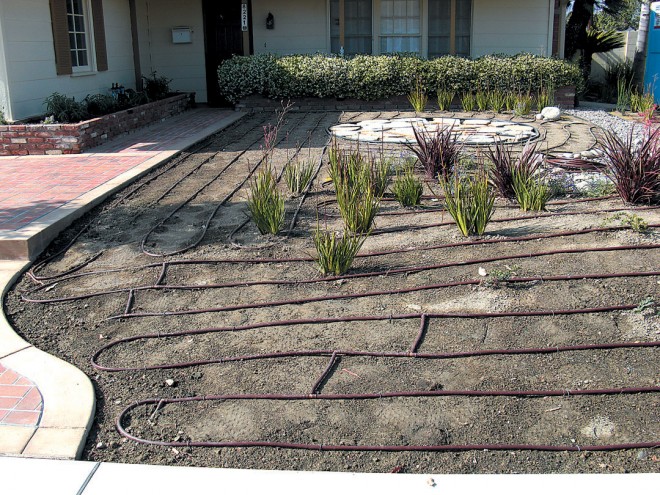
Inspiration for an Oasis
There is a “back story” (to borrow a Hollywood term) for the front garden. A dry creek bed, scattered with boulders, has ended at a shady sanctuary, mimicking a habitat that one might happen upon in a natural setting. There are beautiful flowers and plantings alongside the creek and around the oasis, a refuge for work-weary people. It is alive with hummingbirds and ladybugs, honeybees and sparrows. Except during the occasional Santa Ana wind, this place is a cool and refreshing haven for experiencing nature.
To create a sense of privacy and protection from the street, Guy built a berm, or mound, near the outer edge of the front yard, using the extra dirt excavated for the CUDO Cubes. Planted on top is a coast live oak (Quercus agrifolia) and dwarf New Zealand flax (Phormium tenax ‘Red Warrior’). Scattered about the base of the oak are Pacific Coast Hybrid irises, derived from native species of California and Oregon; their purple and white flowers are etched with contrasting veins and are magical when in bloom between April and July. Neighboring drifts of foothill penstemon (Penstemon heterophyllus ‘Margarita BOP’) and coral bells (Heuchera hybrids) juxtapose delicate purple flowers with vivid red ones.
On the street-side of the berm, a low-growing, drought-tolerant manzanita (Arctostaphylos edmundsii ‘Carmel Sur’), with picturesque reddish bark, nestles among boulders harvested from Malibu, California. We wanted rounded sand-colored boulders, seen throughout Southern California, rather than angular granite ones brought from Montana or the Dakotas. Guy strategically placed different-sized boulders (ranging from one to three feet in diameter) and buried them several inches into the ground. This provides a more natural look, hopefully giving onlookers pause to wonder if the boulders had been always here.
Creeping rosemary (Rosmarinus officinalis ‘Prostratus’) envelops the slope and is also planted in the parkway between sidewalk and curb. This is a tough, fast-growing evergreen shrub, with small, light blue flowers. Its pungent fragrance serves a dual purpose: pleasing passersby while encouraging dogs to go elsewhere.
At the bottom of the berm, edging the sidewalk, is blue fescue (Festuca glauca) arranged in crisp lines of silvery blue green. The foliage is upright and dense, but the soft texture makes it perfect for edging walkways. Pest- and disease-resistant, fescue is carefree and long-lived.
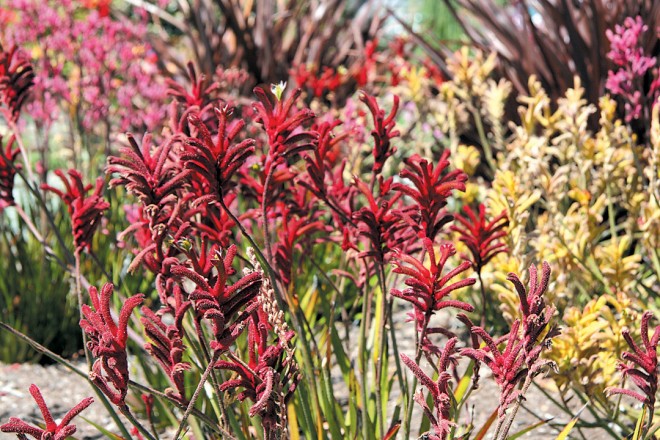
A Secret Garden
On the other side of the berm is our “secret garden.” The focal point is a flagstone circle in the middle of which sits a solar-powered birdbath, much enjoyed by a variety of birds. Woolly thyme (Thymus pseudolanuginosus) fills in the gaps between flagstones. One of the great benefits of the creeping forms of thyme for groundcover is their rapid spread; dividing plants into small plugs at planting time results in speedy dispersal.
There are several pots in the circle planted with sturdy geraniums (Pelargonium xhortorum) and a striking bearded iris, but the star is the exotic red-hot poker (Kniphofia uvaria). Its flame-colored flower spikes reach two to three feet in height; the blossoms produce copious nectar, which attracts bees, butterflies, and hummingbirds.
Encircling the flagstones is common thrift or sea pink (Armeria maritima), which live up to their name by being in an almost constant state of bloom year-round. We live a mile from the ocean, so our plants have to be somewhat salt tolerant as well as drought resistant. Sea pink is a perfect choice for this area since it is both adaptable and low-maintenance. Their domeshaped flower heads are held high, albeit no more than ten inches tall.
When it comes to colorful, nothing gives more pleasure than dwarf kangaroo paws (Anigozanthos flavidus hybrids), with their large, vivid, velvety flowers. When working in the garden, we often chat with people walking by or pulling over in their cars. They all have one question: what is that plant? After giving them the name, we take the opportunity to “plant a seed” by providing information about waterfriendly gardening, hopefully inspiring people to put into practice in their own gardens what we have done in ours.
One section of the front garden retains a lawn-like character. It is planted with Dymondia margaretae, a South African ground cover well suited to dry climates. Once established, it requires no upkeep whatsoever, literally hugging the ground. Small, yellow flowers contrast with the dense, grayish green leaves with white woolly undersides.
Other plants in the original installation included two New Zealand Christmas trees (Metrosideros excelsus), Mexican sage (Salvia leucantha), red yucca (Hesperaloe parviflora) and pride of Madeira (Echium candicans).
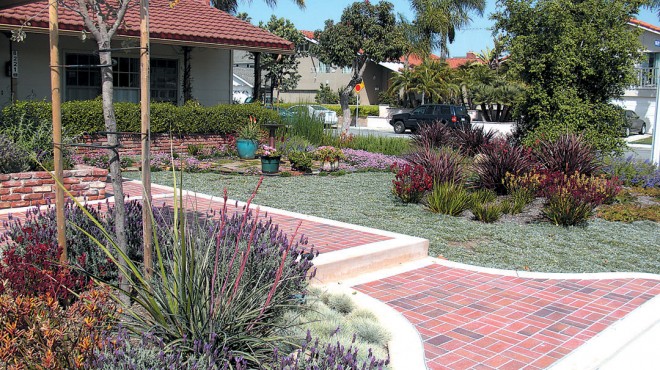
An Encouraging First Year
We were so thrilled with the results that we decided to enter the 2010 Roger’s Gardens California-Friendly Contest in the spring. This first-class nursery devotes much time and energy to educating customers and the community about environmental issues. We were fairly confident of winning the water efficiency category, and the judges agreed, impressed that there was absolutely no water lost when our garden was tested. However, we did not anticipate being awarded the grand prize. What a tremendous honor for neophyte gardeners.
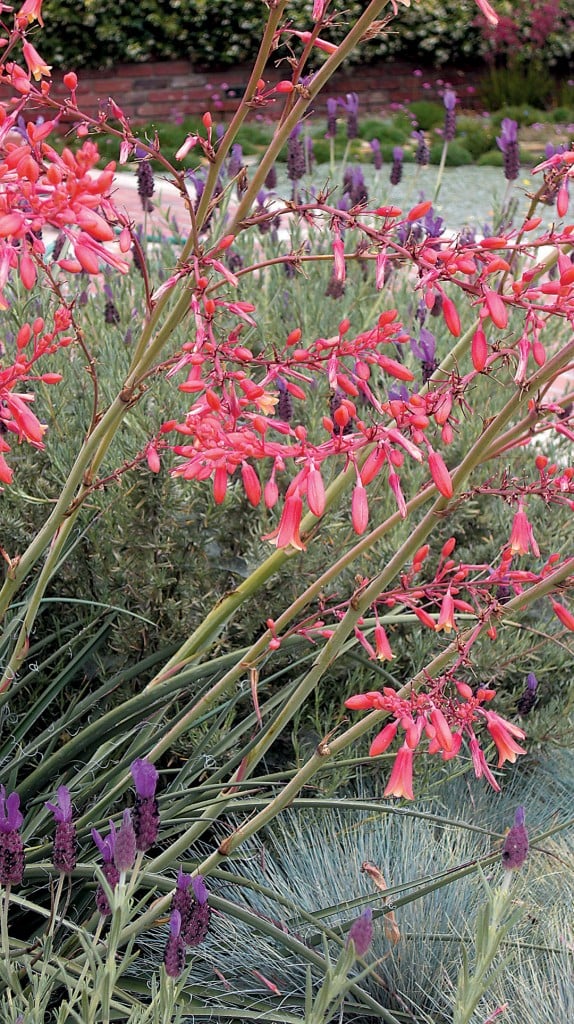
We then felt further inspired to spread the word about responsible gardening that benefits the environment, so Amanda created our website. Within the site are before-and-after photos that document the journey, along with a host of resources and information on topics such as carbon sequestration and soil microbiology, with links to more resources on the internet. There is also a link to the company that services the yard, Eco Green Team; owner Raul Rodriguez is passionate about organic gardening and an expert in efficient water management.
We have cut our water usage by more than half, achieving an estimated water savings of 12,716 gallons (in summer) and 9,724 gallons (in winter)—per month! The summer savings is equivalent to the amount of water in a 15′ x 30′ x 4′ swimming pool. Water usage will continue to decline as the plants mature. This results in a concurrent reduction of electrical power—and reduced environmental impact—required to pump the water from Northern to Southern California.
We have learned that home gardeners can be active stewards for our environment. We have crossed the bridge from unthinking consumer to responsible resident, thinking globally and acting locally. We hope you’ll join us in the effort to preserve our beautiful planet for future generations.
Share:
Social Media
Garden Futurist Podcast
Most Popular
Videos
Topics
Related Posts

Ground Up Science for Greener Cities with Garden Futurist Dr. Alessandro Ossola
Spring 2023 Listen to the Podcast here. Alessandro Ossola is a scientist who gets very excited about the challenge of climate change allowing for an

Readying Urban Forests for Climate Realities with Garden Futurist Dr. Greg McPherson
Winter 2023 Listen to the Podcast here. “Going from the mow and blow to a more horticulturally knowledgeable approach to maintaining the landscape. And that

Low Maintenance Gardens – Better for Pollinators and People
Autumn 2022 “I come out every day. It’s therapy, my meditation.” Janet’s young garden transformed from overgrown, invasive plants to mostly natives. The dailiness of

Invasive Plants Are Still Being Sold: Preventing Noxious Weeds in Your Landscape
Autumn 2022 With so many beautiful ornamental plant species and cultivars throughout California and the Pacific Northwest, how do you decide which ones to include









Responses